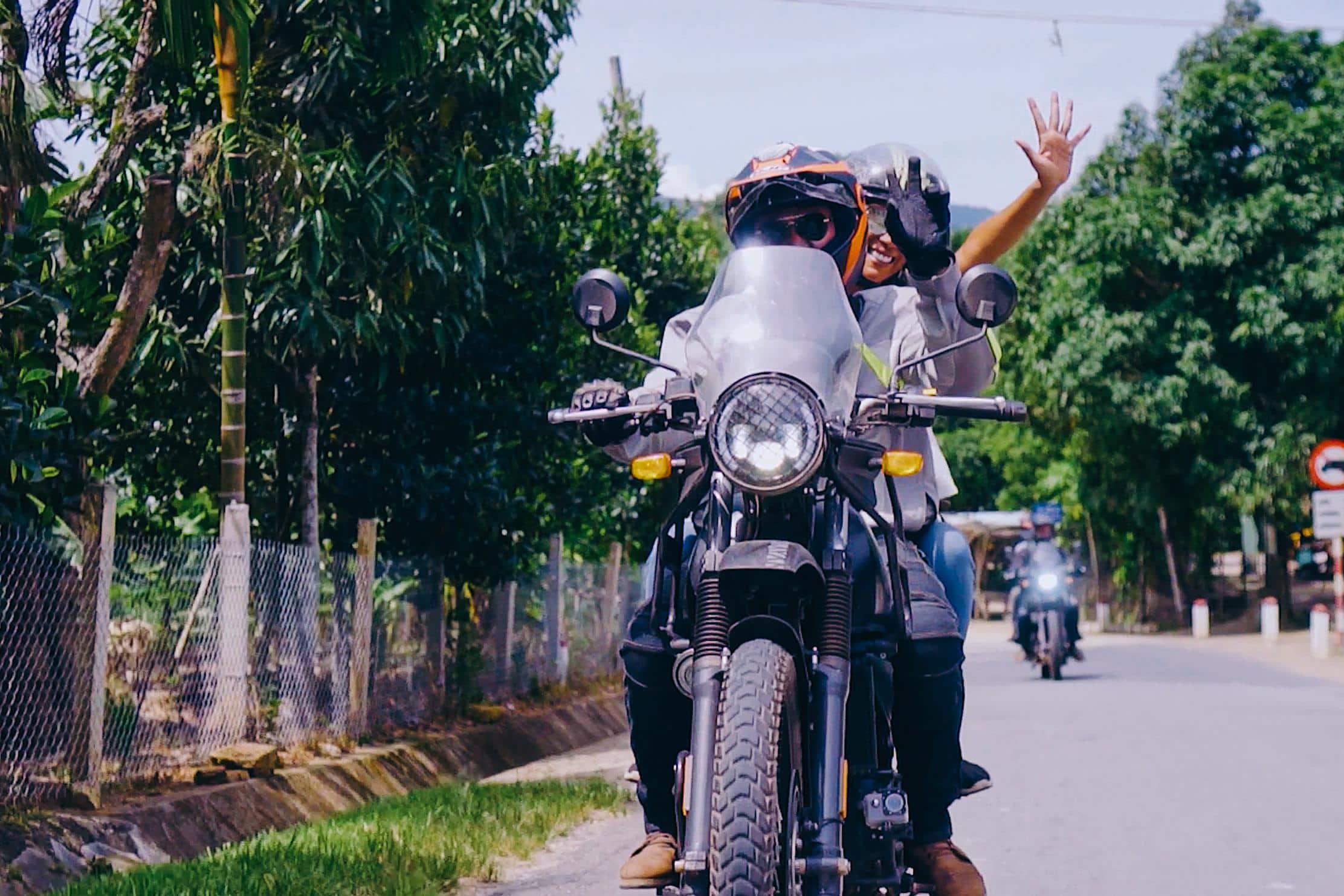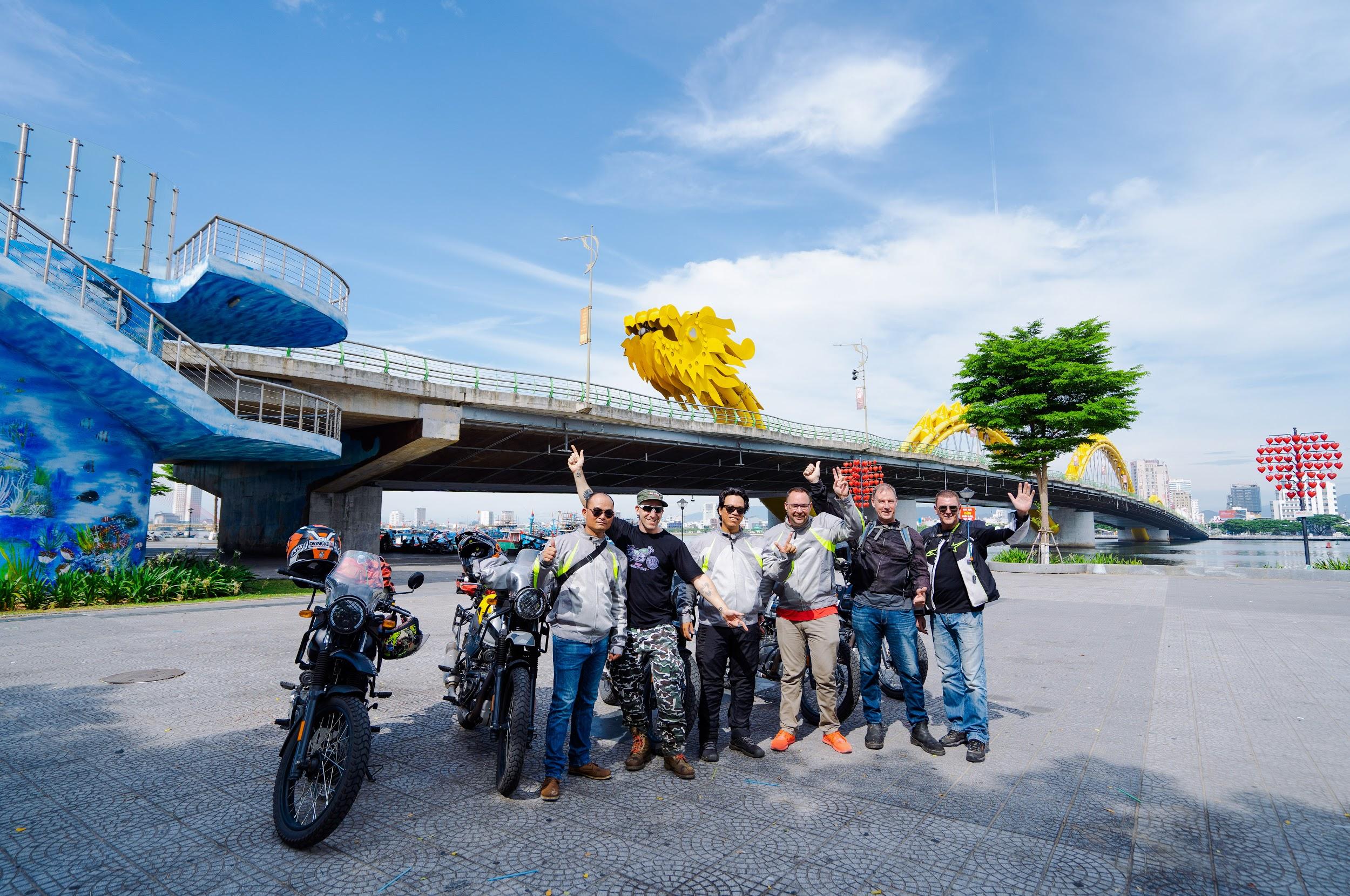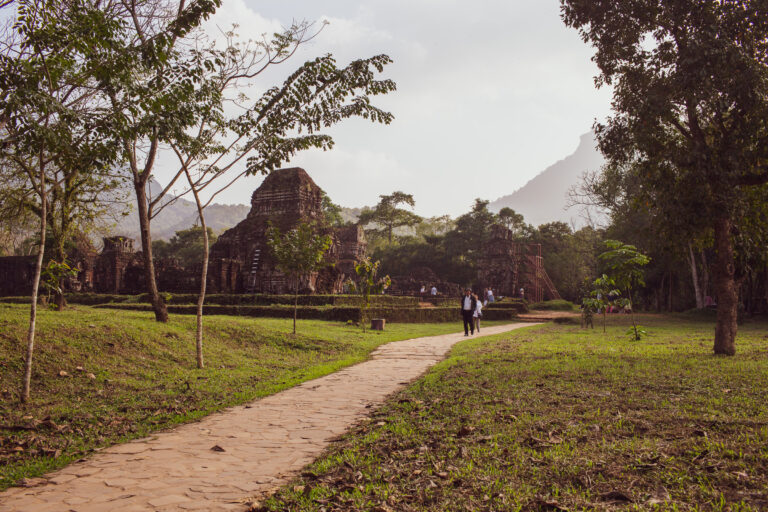
Home > Blog > Travel Guides > Hoi An to Hue by Motorbike
Hoi An to Hue by Motorbike
Share:
- Published:
- Updated: 20/01/25

The 120 kilometers or so from Hoi An to Hue is home turf for Onyabike Adventures. We’re happy to call this area home, not least because the area is blessed with some world-class riding.
Options abound on a ride from Hoi An to Hue or vice versa. You can take this trip as fast or as slow as you want. There are enough pleasant distractions to keep even the most destination-oriented rider happily busy for a long time.
Below we’ll follow the route from Hoi An to Hue, detailing attractions and detours along the way. If you’re driving from Hue to Hoi An instead, simply imagine this article in reverse. Maybe try reading it upside down to see if it helps.
Table of Contents
Hoi An to Da Nang
Driving from Hoi An to Da Nang takes roughly a half hour to 45 minutes, depending on your speed and route. The most common drive is to take the beach road — which, unfortunately, doesn’t get much of a beach view since resorts have taken up beach property all the way to Da Nang.
An alternative route is to take DT607, Da Nang’s east side highway. If you start on the west side of Hoi An, this may be your choice, though it’s not a particularly romantic drive.
Usually, people drive a straight line from Hoi An to Da Nang since there isn’t much to see on the way. There are, however, two reasonably interesting attractions.
Marble Mountain
The most notable would be Marble Mountain (Ngu Hanh Son), for which the district of town gets its name. A pagoda sits atop one of the five giant slabs of marble sticking out of the ground, with various temples carved on top of it and into its caves. It can be accessed via stairs or via elevator. The entry fee to the pagoda is 15,000 VND (~.$.60), and the elevator is an additional 15,000 VND.
The pagoda at the top of the mountain symbolizes heaven; an additional temple built into a cave under the mountain symbolizes hell. It’s full of statues made to look like demons and is definitely worth a stop if you’re already visiting the area. It’s easy to overlook the ‘hell’ bit, so make sure you don’t miss it.
Marble Mountain is one of those tourist attractions that are good to visit once, but most people don’t go flocking back to. If you’re in a hurry, it’s no big miss to skip it. However, if you have some time to spend, it’s definitely worth a visit.
Non Nuoc Beach
Non Nuoc beach is just to the east of Marble Mountain and is simply a public beach access point. However, it’s got some of the least crowded stretches of sand and some of the cleanest water around for a good swim. It also features a long-term Da Nang mainstay: Hoa’s place, run by Mr Hoa himself. He is a local legend and his establishment offers a large menu with everything from quality burgers to local cuisine, as well as ice-cold beer.
Son Tra Peninsula/Monkey Mountain
One of the city’s main bragging points when it comes to a motorcycle trip is Son Tra peninsula, frequently called Monkey Mountain. Check out our latest video on Son Tra Peninsula or Monkey Mountain to learn more. It’s earned that name due to the rare Red-Shanked Douc Langurs that call the mountain home, as well as a troop of less-rare macaques that also inhabit the jungle.
Roads hug the edge of the peninsula, offering unbeatable views of the city from high cliffs over the sea. An 800-year-old banyan tree sits on the northeast side of the peninsula, well worth a visit — especially for its shade in the hot season (May-August).
The peninsula also features the Lady Buddha statue as well as Linh Ung pagoda, tourist staples. These may be overwhelmed with Chinese or Korean tourists depending on what time of day you go, so don’t be surprised to find a crowd if you choose to visit.
Another attraction worth seeing in Da Nang is its famous Dragon Bridge. Most of the time, the bridge is just that: a way to get across the river. On Saturday and Sunday evenings, however, it spits fire and water. Like Marble Mountain, it’s one of those tourist attractions that’s good to visit if you have time, but is not an absolute must-see on an itinerary.
Da Nang to Lang Co from Hoi An to Hue
Heading from Da Nang to Lang Co is one of the best short drives in the whole country, and maybe even the world.
Hai Van Pass
The highlight of the drive is the Hai Van Pass, made world-famous by the BBC’s Top Gear in 2008. They say it’s one of the best mountain roads in the world, and we happen to agree.
The drive up the pass starts to the northwest of Da Nang, and climbs 500 meters in a short 21-kilometer drive, though the mountains climb much higher. Despite its short length, this road packs some serious fun in the form of twists, turns, and views into that short drive that you may want to go on it again like a roller coaster.
In the event of bad weather, there is a tunnel that goes under the mountain. While the tunnel negates nearly all the fun of the road, it’s an excellent choice to avoid dangerous storms that can occur on the pass.
We’ve covered the Pass in great detail in another article — check it out if you want to expand your knowledge of this gem of mountain driving.
Lang Co
Lang Co is a sleepy hamlet sandwiched between the beach and the mountain-ringed lagoon at its backside. If you’re making the trip from Hoi An to Hue or vice versa in one day, this is an excellent place to stop for lunch. The town can be seen from a spot made famous on Top Gear by Jeremy Clarkson — check out our article here for the full scoop.
Several floating restaurants sit on the lagoon side of town, serving seafood in a relaxed and truly beautiful setting. In the wetter months (September-January) clouds top and spill over the mountains in an almost otherworldly fashion.
One of the highlights of these restaurants is something that’s hard to find in much of the country. Vem (mussels) found here are delightful, often served grilled with spring onion and peanuts.
The road curls around the lagoon, which can make for a relaxing break as it’s usually light with traffic. If you want, you could even take a back route along the west side of the lagoon rather than continuing straight along Highway 1. You’ll eventually link back with highway 1, but this is certainly the road less traveled.
Lang Co to Hue

Leaving Lang Co, you can make a choice. Either head north along the beach road to Chan May bay or go along Highway 1 to Sui Voi (Elephant Springs). Chan May bay offers a multi-kilometer crescent of relatively undeveloped and quiet beach, with several guesthouses. If you’re in no hurry and want to stay somewhere peaceful while taking it easy, this is a good choice. There are seafood restaurant and options for tent camping along the beach as well.
Elephant Springs
Many travelers want to visit Elephant Springs, however, and to do this you’ll need to continue along Highway 1. Elephant Springs is popular with locals and tourists alike. Here you can find a series of waterfalls with man-made pools.
Generally, the higher up you go the cleaner the water is — litter can be a problem towards the bottom. Around the springs you’ll also find vendors selling grilled chicken and other snacks.
Bach Ma National Park
West of Lang Co is a huge swath of jungle and mountain: Bach Ma National Park. Here is a near paradise for those looking for hiking, jungle trekking, or waterfall searching. Paths are well-labeled and there is lodging available to spend the night.
Do note that you can’t drive your motorbike all the way into Bach Ma park. Instead, you’ll have to park at the entrance. Buses are available to take you to the top — a 1,200-meter climb over 15 kilometers. It costs around 1 million VND (~$45) for the bus, which takes up to six people.
The Tunnel or the Mountain Road?
Not far after the turnoff to Elephant Springs is another choice: take the Phuoc Tuong tunnel or take the pass road over the mountain. While either choice works, taking the mountain road rather than the tunnel is our preference. You’ll get unbeatable views of the lagoon from the elevation it provides. What’s more, you’ll get to play on some more winding roads rather than going through a straight tunnel.
In the event of rain or strong wind, however, taking the tunnel will be a safer bet. There’s no point in risking taking the pass road if there’s no visibility, anyway.
From Hoi An to Hue: Beach Road or Highway 1?
Next, you’ll be faced with another choice: approach Hue via the beach road that curves along the ocean or take the straighter route via Highway 1. If you’re headed towards Bach Ma, take Highway 1. If not, take the beach road.
We much prefer taking the beach road. While Highway 1 will get you to Hue faster, the beach road is far more interesting, less busy, and much prettier. No surprises there — you’re driving along the coast.
There are some surprises along the beach road, however. One of them is an ancient temple that was the first pagoda built by the Nguyen dynasty: Tuy Van Dinh. The temple is a historical landmark and important place of worship. It also has the added bonus of its location: It can give you some of the best views of the lagoon from anywhere around. It’s definitely worth a detour along the way.
Cemeteries and tombs
Additional fun fact: The series of lagoons you’ll be driving along here is one of the biggest, if not the biggest, brackish water lagoon systems in the world. It’s rich in life and full of all sorts of marine species and has consequently provided sustenance for locals for centuries.Once you get to Thuan An beach, you’ll turn southwest and approach Hue from the north. Thuan An beach is a fine destination in its own right, and well worth a stop if you have the time.
In Hue

Hue, the former imperial capital of the Nguyen dynasty, is a popular stop on any North-South or South-North trip. Highlights include the old Imperial Citadel, the riverside markets, and the unique cuisine that is nationally famous
Hue was heavily damaged by the war, so much of the city is relatively new. However, some older buildings still exist, including the Imperial Citadel.
If you ride with Onyabike Adventures, we’ll have you from Hoi An to Hue in time to see the Citadel and enjoy some time to wander around the city.
Alternative Transport from Hoi An to Hue
Of course, riding a motorbike isn’t the only way to get from Hoi An to Hue or vice versa. Several other options are available: pillion tours, trains, buses, and private cars. Of course, you could walk — everywhere is walking distance if you have the time — but most people choose not to.
Pillion Tours from Hoi An to Hue
A Pillion (passenger) tour can be a great choice if you want to ride a motorbike on this route but you don’t have the licensing or experience needed. If you ride with us, for example, you’ll get the benefit of an experienced, knowledgeable guide as well as a comfy seat on the back of the bike tour with a top-notch motorcycle.
Taking a motorbike tour will give you far more freedom than you could experience in other forms of transport like a car or a bus. You’ll get to see much more of the authentic, back-road countryside and can make snap decisions to go down a tempting road if you want. It’s the sort of freedom that makes an adventure feel like an adventure.
Do note that while many people choose to drive without a license in Vietnam, doing so is still illegal and can lead to fines or motorbike confiscation if the police decide to stop you. Additionally, if you run into any trouble — like an accident — your insurance will not cover you if you’re riding illegally.
Also bear in mind that some of the roads mentioned on this trip are not a good idea to take if you’re unfamiliar with driving a motorbike. Hai Van Pass, for example, features lots of twists and turns up on steep roads with trucks to pass. It’s not the best idea for a brand new rider to attempt the road.
If you’re riding pillion, you can be assured your driver knows what they’re doing and has tons of experience on these roads. It’s a way to take the edge off and breathe easier.
Train from Hoi An to Hue
There is indeed a train line that runs from Da Nang to Hue. It’s part of the nationwide north-south line known as the Reunification Express. It runs daily and will cost around $10-12 depending on the type of seat you get.
The train does go through some beautiful scenery, especially along the Hai Van pass.
Note: There is no train station in Hoi An. If you intend to go by train you must use the train station in Da Nang.
Bus from Hoi An to Hue
Buses of several varieties go between Hue and Hoi an all the time. While you can research all sorts of different bus companies, they’ll all roughly be the same and the trip isn’t long enough to make lots of research worth it. The simplest thing to do is to ask the reception at your lodging about a bus and they’ll make a phone call for you. It can all be arranged in less than a few minutes. Prices will range around $5-10 USD and the bus companies say they’ll usually take around 5-6 hours. However, the schedules are not exact and sometimes buses take longer than they announce. If you have a flight or other connecting transport, allow plenty of time so you don’t miss it while sitting on a bus.
Also worth noting is that buses can be uncomfortable for those who are on the large side. Buses are built for smaller people than those in western countries, which can lead to serious consternation on longer trips. Additionally, many Vietnamese bus drivers have maniacal tendencies like overtaking trucks on blind mountain turns or honking constantly while chugging Red Bull. Buses are cheap, but you get what you pay for.
Onyabike Adventures’ Thoughts
A motorbike trip between Hoi An and Hue or vice versa is a must for any travel adventurer or adventure rider looking to visit the country. You’ll see some of the country’s best highlights along the way and set yourself up for further trips afterwards.
Lots of our trips feature this route, and for good reason. And hey, there’s no need to stop in Hoi An or Hue — there’s plenty more of the country to see.
Related Posts
Recent Posts






